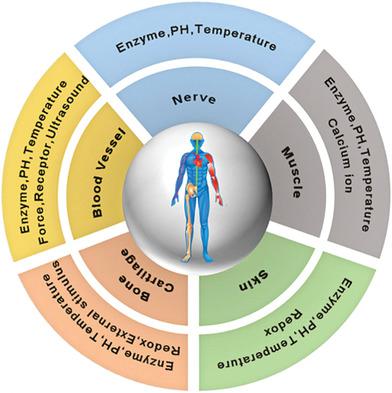当前位置:
X-MOL 学术
›
Adv. Healthcare Mater.
›
论文详情
Our official English website, www.x-mol.net, welcomes your feedback! (Note: you will need to create a separate account there.)
Stimuli-Responsive Delivery of Growth Factors for Tissue Engineering.
Advanced Healthcare Materials ( IF 10.0 ) Pub Date : 2020-03-03 , DOI: 10.1002/adhm.201901714 Moyuan Qu 1, 2 , Xing Jiang 1, 3 , Xingwu Zhou 1, 4 , Canran Wang 1, 5 , Qingzhi Wu 1, 6 , Li Ren 1, 7 , Jixiang Zhu 1, 8 , Songsong Zhu 2 , Peyton Tebon 1 , Wujin Sun 1 , Ali Khademhosseini 1, 4, 9
Advanced Healthcare Materials ( IF 10.0 ) Pub Date : 2020-03-03 , DOI: 10.1002/adhm.201901714 Moyuan Qu 1, 2 , Xing Jiang 1, 3 , Xingwu Zhou 1, 4 , Canran Wang 1, 5 , Qingzhi Wu 1, 6 , Li Ren 1, 7 , Jixiang Zhu 1, 8 , Songsong Zhu 2 , Peyton Tebon 1 , Wujin Sun 1 , Ali Khademhosseini 1, 4, 9
Affiliation

|
Growth factors (GFs) play a crucial role in directing stem cell behavior and transmitting information between different cell populations for tissue regeneration. However, their utility as therapeutics is limited by their short half-life within the physiological microenvironment and significant side effects caused by off-target effects or improper dosage. "Smart" materials that can not only sustain therapeutic delivery over a treatment period but also facilitate on-demand release upon activation are attracting significant interest in the field of GF delivery for tissue engineering. Three properties are essential in engineering these "smart" materials: 1) the cargo vehicle protects the encapsulated therapeutic; 2) release is targeted to the site of injury; 3) cargo release can be modulated by disease-specific stimuli. The aim of this review is to summarize the current research on stimuli-responsive materials as intelligent vehicles for controlled GF delivery; Five main subfields of tissue engineering are discussed: skin, bone and cartilage, muscle, blood vessel, and nerve. Challenges in achieving such "smart" materials and perspectives on future applications of stimuli-responsive GF delivery for tissue regeneration are also discussed.
中文翻译:

用于组织工程的生长因子的刺激响应传递。
生长因子(GF)在指导干细胞行为和在不同细胞群之间传递信息以促进组织再生方面发挥着至关重要的作用。然而,它们作为治疗剂的用途受到其在生理微环境中半衰期短以及脱靶效应或剂量不当引起的显着副作用的限制。“智能”材料不仅可以在治疗期间维持治疗递送,而且还可以在激活时促进按需释放,引起了组织工程 GF 递送领域的极大兴趣。在设计这些“智能”材料时,三个特性至关重要:1)货运工具保护封装的治疗剂;2)针对受伤部位进行释放;3)货物释放可以通过疾病特异性刺激来调节。本综述的目的是总结当前刺激响应材料作为受控 GF 递送智能载体的研究;讨论了组织工程的五个主要子领域:皮肤、骨骼和软骨、肌肉、血管和神经。还讨论了实现此类“智能”材料的挑战以及刺激响应性 GF 递送在组织再生中的未来应用前景。
更新日期:2020-04-08
中文翻译:

用于组织工程的生长因子的刺激响应传递。
生长因子(GF)在指导干细胞行为和在不同细胞群之间传递信息以促进组织再生方面发挥着至关重要的作用。然而,它们作为治疗剂的用途受到其在生理微环境中半衰期短以及脱靶效应或剂量不当引起的显着副作用的限制。“智能”材料不仅可以在治疗期间维持治疗递送,而且还可以在激活时促进按需释放,引起了组织工程 GF 递送领域的极大兴趣。在设计这些“智能”材料时,三个特性至关重要:1)货运工具保护封装的治疗剂;2)针对受伤部位进行释放;3)货物释放可以通过疾病特异性刺激来调节。本综述的目的是总结当前刺激响应材料作为受控 GF 递送智能载体的研究;讨论了组织工程的五个主要子领域:皮肤、骨骼和软骨、肌肉、血管和神经。还讨论了实现此类“智能”材料的挑战以及刺激响应性 GF 递送在组织再生中的未来应用前景。


























 京公网安备 11010802027423号
京公网安备 11010802027423号